Answer these simple questions and we will find you the BEST prices
Which type of solar quotes do you need?
It only takes 30 seconds
100% free with no obligation

Get Free quotes from insulation specialists near you

Save money by comparing quotes and choosing the most competitive offer

The service is 100% free and with no obligation
- GreenMatch
- Insulation
- Wall Insulation
- Cavity Wall Insulation
- Retrofit Cavity Wall Insulation
Retrofit Cavity Wall Insulation: Problems, Types & Cost (2025)

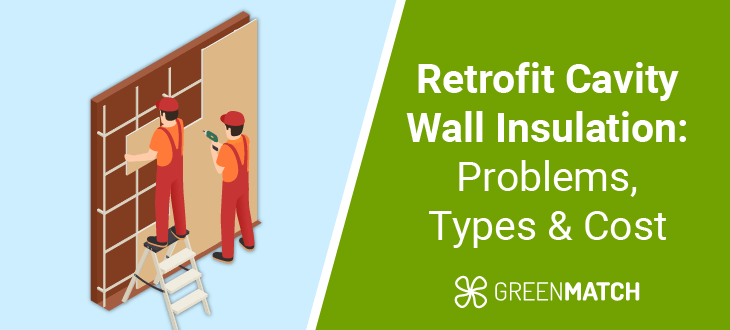
- Retrofitting cavity walls can improve your energy savings by 10% on average.
- Polystyrene beads and polyurethane are the best retrofit insulation materials available.
- Insulation costs range between £1,000 to £4,600 depending on the size of your home.
Installing a retrofit cavity wall insulation is a great way to reduce your energy consumption and create a sustainable home. Retrofitting comes with a lot of complex factors like what material to choose, how much the entire project will cost, and what insulation grants you can obtain.
Let’s go over all of these topics and judge whether insulation is right for you.
If you’re looking for the right insulation for your retrofit, it’s best to consult a professional installer. A reliable installer can help you navigate prices and provide excellent service. Although finding one can take days of research and price comparisons, it doesn’t have to. Our service can streamline your search and give you the best insulation options.
Fill out our simple, 30-second form and receive prices from up to 3 insulation experts. All quotes are free and have no payment obligation attached to them. Click the button below to get started.
- Describe your needs
- Get free quotes
- Choose the best offer
It only takes 30 seconds



How does retrofit cavity wall insulation work?
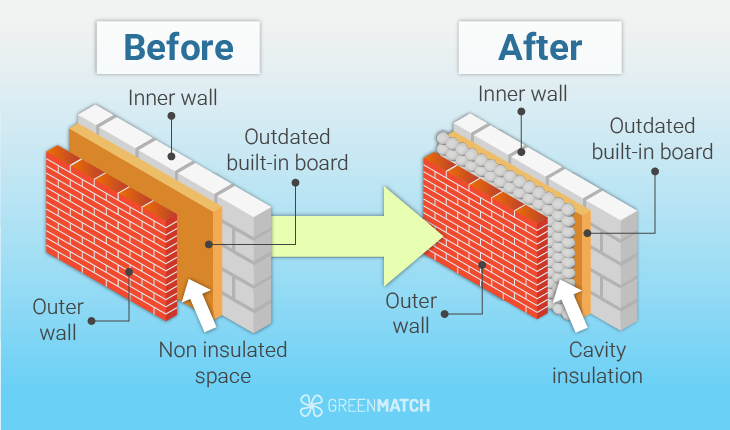
Retrofit cavity wall insulation works by inserting a material in the spaces within the wall cavity. This can help reduce heating costs and carbon emissions for the average home. It also carries other benefits such as noise reduction and better airflow. The effectiveness of all these characteristics depends on the material chosen.
Retrofitting only applies to existing homes and not to new builds, which alters the types of insulation that will apply to the average home. For example, most retrofits will be done with drill holes rather than extensive wall renovation, which makes foams and beads more appropriate.
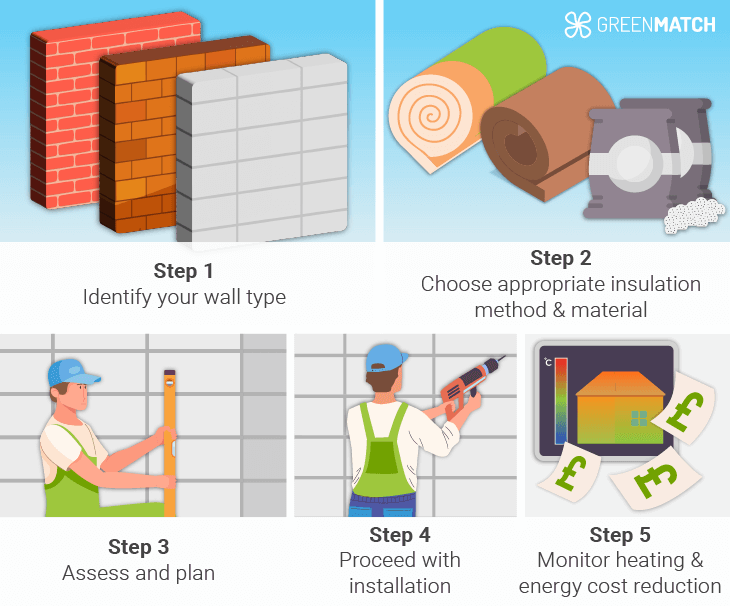
Identify Your Wall Type
The first step is to determine whether your home has solid or cavity walls. This comes down to how much space it has available, so you can measure wall thickness at an opening. If it has less than 260mm of space it is most likely a solid wall. However, if it has more than 260mm, it has a decent cavity that you can work with.
Another identifier is the brickwork. Solid walls tend to have uneven brickwork, with bricks laid lengthways and widthways. Conversely, cavity walls will display evenly spaced brickwork all laid lengthways.
In most cases, professional installers can also provide a wall survey to determine your type of wall and its condition.
Choose the Appropriate Insulation Method & Materials
Once you’re sure you have a cavity wall you can work with, a professional installer insulates the cavity space by blowing material into the cavity with specialised equipment. Your chosen material will depend on the type of wall, the specifications of the home, and what you can afford. Common materials include fibreglass, polyurethane, polystyrene, and natural fibres like sheep’s wool.
Assess and Plan
It’s worth having them assessed by a qualified surveyor since it can be an extensive job. It’s best to plan the insulation installation with a licensed professional, preferably a National Insulation Association or Cavity Insulation Guarantee Agency member.
Proceed with Installation
For retrofit installations, the process is far simpler. An installer will drill small holes around the building and blow insulation material - such as polystyrene beads, mineral fibre, or polyurethane foam into the cavity using specialised equipment. Once the material has been inserted, it’s time to seal the holes after completion. This can take a few hours, although an experienced installer can get it done in 2 hours, which is why we recommend contracting NIA-approved or CIGA-certified installers.
Monitor Heating & Energy Cost Reduction
Keep track of your bills and the airflow in your home. If you are feeling less of a draught and lower monthly bills, the insulation worked. Homeowners should expect a 10% reduction in their bills on average compared to an uninsulated wall.
Types of retrofit cavity wall insulation
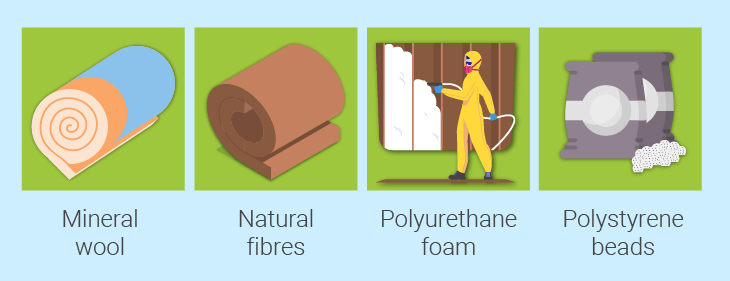
- Polystyrene beads: An affordable bead-based alternative to polyurethane that is gaining popularity due to its relative sustainability. It has lower thermal conductivity and noise reduction capabilities but can be better for protection against damp conditions. As a material, Polystyrene beads provide the best cavity wall insulation price compared to functionality.
- Polyurethane foam: Polyurethane foam is easy to install as it can be poured through a few tiny holes in the wall. It is also a good insulator while also offering decent cavity wall insulation soundproofing. While it is a great material, cheaper polyurethane foams can degrade quickly, so it's best to opt for better ones.
- Mineral wool: Often consisting of stone or glass fibre, mineral wool comes in batts or slabs that can be placed as internal or external insulation. For cavity walls, mineral wool is easy to install but cannot be passed through drill holes like foams or beads. It is particularly effective for brick walls but less so for wood which is under threat from moisture.
- Natural fibres: Natural fibres like sheep wool can be a great insulator. It can prevent moisture on wood elements and act as an effective insulator. It can be relatively expensive compared to plastics and needs to be properly treated to ward off insects, but it is a good option nonetheless.
| Insulation material | R-value (m²K/W) | U-value (W/m²K) | Average cost (per m2) |
|---|---|---|---|
| Polystyrene (EPS) | 2.6 - 3.3 | 0.030 - 0.038 | £10 |
| Polyurethane | 3.6 - 4.5 | 0.022 - 0.028 | £21.5 |
| Mineral Wool | 2.5 - 3.3 | 0.030 - 0.040 | £13 - £17.5 |
| Natural Fibres | 3.5 - 4.5 | 0.22 - 0.29 | £17.5 - £22 |
Retrofit cavity wall insulation cost
A cavity wall insulation retrofit project does not necessarily have to be expensive. Insulation can cost about £1,000 on average for a mid-floor flat, while a detached bungalow can cost £2,100. Detached houses are the most expensive, costing £4,600.
| Type of home | Average cost | Annual savings | Payback period |
|---|---|---|---|
| Detached house | £4,600 | £405 | 11 years |
| Semi-detached house | £2,700 | £235 | 11 years |
| Mid-terrace house | £1,500 | £140 | 11 years |
| Detached bungalow | £2,100 | £175 | 12 years |
| Mid-floor flat | £1,000 | £110 | 9 years |
So, how often does cavity wall insulation need renewing? While it can vary, most insulation measures last 25 years on average. As most insulation will pay back in about 9 to 11 years, you’ll generate 10% savings on bills for roughly another decade and a half.
There are also ways to help mitigate the costs of insulation through government programs and incentives, ensuring your payback period is even smaller. Grants for insulation include ECO4 and the Great British Insulation Scheme, which can both pay for a partial or full installation. Both are geared towards low-income households and are means-tested.
It’s worth keeping in mind that the prices above are averages. Contacting an installer is the best way to get prices suited to your home’s exact needs. Moreover, an installer can even help you navigate grants and installation processes. Finding a reliable installer can be a hassle that takes days but, with our services, you can quickly find the right installer with no effort on your part.
Fill out one short, 30-second form and we’ll provide you with up to 3 free, non-binding quotes from reputable installers in your area. Click the button below to get started.
- Describe your needs
- Get free quotes
- Choose the best offer
It only takes 30 seconds



Retrofit cavity wall insulation problems
Cavity wall insulation problems occur rarely but can be something to look out for. These can include:
- Cavity space: To be insulated, a cavity space has to be at least 50mm wide. Cavity wall insulations for old houses can be risky since they may have less space between walls.
- Poor workmanship: Improper installation can lead to a series of problems down the line, including dampness and mould growth. Exposure to wind-driven rain can exacerbate this issue. Hiring installers guaranteed by the Cavity Insulation Guarantee Agency (CIGA) can help evade this problem, and even secure you a 25-year guarantee.
- Damaged walls: Walls with poor sealing can cause water ingress and lead to saturated insulation and interior wall damage. It’s important to get any cracks and gaps in your outer wall properly sealed.
- Outdated materials: Older types of insulation, such as formaldehyde are no longer used in the market. It tends to shrink and emit toxic fumes. Such insulation would need to be removed before new insulation can be installed.
Our best advice to deal with potential issues is to be aware of signs of cavity wall insulation failure and to contact property care associations for surveys if problems arise. There are also numerous online resources on how to check cavity wall insulation.
Pros and cons of retrofit cavity wall insulation
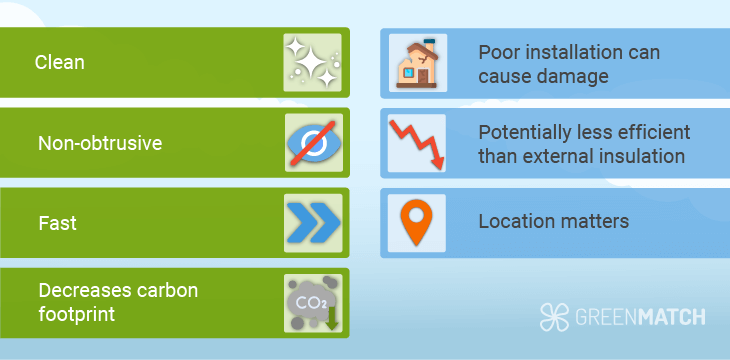
Pros:
- Clean: Unlike many other forms of home improvement, inserting insulation into a cavity wall is fairly clean. It doesn’t cause much of a mess since it involves drilling holes and pouring or filling material into them rather than engaging in large-scale renovation.
- Non-obtrusive: Cavity wall insulation can be far less intrusive for the home and the residents, particularly when foams are used. It doesn’t require an overhaul of the whole house and can be conducted with little disruption to daily life.
- Fast: An experienced installer can often complete the process within 2 hours, although it can often take longer. It can rarely take more than a day’s work, which is far less than many other forms of home renovation.
- Decreases carbon footprint: Due to the decrease in energy consumption, the average home can mitigate its carbon emissions by 670kg per year.
- Comparatively affordable heating solution: For smaller homes, insulation can often cost £1,000, while saving 10% of their heating costs annually for decades to come. Compared to installing a new heating system, which can exceed these costs, it has a decent return on investment.
Cons:
- Poor installation can cause damage: Dampness issues, mould, and structural damage can result from poor installation.
- Potentially less efficient than external insulation: External wall insulation is sometimes more effective.
- Location matters: Unexposed homes that are subject to wind-driven heavy rain are likely to have outer walls that will get soaked quicker and for longer. Such properties might benefit from a different type of wall insulation, such as internal wall insulation.
Should I get cavity wall insulation for my retrofit?
Retrofitting insulation into a cavity wall can be worth it as it can decrease energy consumption by 10%, resulting in between £110 to £405 decrease in bills depending on the size of your home. While insulation costs can range between £1,000 to £4,600 depending, numerous insulation grants can pay a significant portion of the costs.
If prices are a concern, numerous grants can cover the cost of cavity wall insulation in the UK. The ECO4 and the Great British Insulation Scheme can both provide funding for partial or even full work on your home. They are geared towards low-income households so try applying for them to see if you qualify.
That said, if you’re looking to see whether insulation is appropriate for your home, we recommend contacting a professional insulation expert. Finding a reliable expert can save on insulation costs and allow for better installation but finding one can be a hassle that often takes days of diligent research. Luckily, with our quick and easy service, it doesn’t have to!
Fill out a simple 30-second form and we’ll provide you with free, non-binding quotes from up to 3 vetted installers from our network. Click the button below to get started.
- Describe your needs
- Get free quotes
- Choose the best offer
It only takes 30 seconds



FAQ
Polyurethane and polystyrene can be the best materials for retrofitting cavity walls. Which one you choose can vary based on how extensive your installation process is.
Yes. Retrofitting wall insulation can result in a 10% decrease in heating bills and pays itself back in 10 years on average. Despite the costs, it can also allow for better noise reduction and sustainability.
Generally, foam is inserted through holes drilled into the walls. You can also insert insulation batts by removing the wall or panelling although this is more difficult. The method depends on the type of insulation required.
Retrofitting insulation into a cavity wall is adding layers to cover up empty spaces which are creating heating inefficiencies. An installer will insert foam or place insulation batts inside the wall during a retrofit.

Rawal Ahmed is a writer at GreenMatch with an interest in sustainability and a background in tech journalism and digital marketing.
We strive to connect our customers with the right product and supplier. Would you like to be part of GreenMatch?

- Retrofit Cavity Wall Insulation: Problems, Types & Cost (2025)
- How does retrofit cavity wall insulation work?
- Types of retrofit cavity wall insulation
- Retrofit cavity wall insulation cost
- Retrofit cavity wall insulation problems
- Pros and cons of retrofit cavity wall insulation
- Should I get cavity wall insulation for my retrofit?
- FAQ
